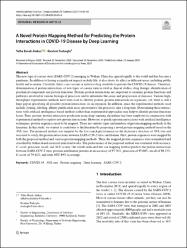| dc.description.abstract | The new type of corona virus (SARS-COV-2) emerging in Wuhan, China has spread rapidly to the world and has become a pandemic. In addition to having a significant impact on daily life, it also shows its effect in different areas, including public health and economy. Currently, there is no vaccine or antiviral drug available to prevent the COVID-19 disease. Therefore, determination of protein interactions of new types of corona virus is vital in clinical studies, drug therapy, identification of preclinical compounds and protein functions. Protein-protein interactions are important to examine protein functions and pathways involved in various biological processes and to determine the cause and progression of diseases. Various high-throughput experimental methods have been used to identify protein-protein interactions in organisms, yet, there is still a huge gap in specifying all possible protein interactions in an organism. In addition, since the experimental methods used include cloning, labeling, affinity purification mass spectrometry, the processes take a long time. Determining these interactions with artificial intelligence-based methods rather than experimental approaches may help to identify protein functions faster. Thus, protein-protein interaction prediction using deep-learning algorithms has been employed in conjunction with experimental method to explore new protein interactions. However, to predict protein interactions with artificial intelligence techniques, protein sequences need to be mapped. There are various types and numbers of protein-mapping methods in the literature. In this study, we wanted to contribute to the literature by proposing a novel protein-mapping method based on the AVL tree. The proposed method was inspired by the fast search performance on the dictionary structure of AVL tree and was used to verify the protein interactions between SARS-COV-2 virus and human. First, protein sequences were mapped by both the proposed method and various protein-mapping methods. Then, the mapped protein sequences were normalized and classified by bidirectional recurrent neural networks. The performance of the proposed method was evaluated with accuracy, f1-score, precision, recall, and AUC scores. Our results indicated that our mapping method predicts the protein interactions between SARS-COV-2 virus proteins and human proteins at an accuracy of 97.76%, precision of 97.60%, recall of 98.33%, f1-score of 79.42%, and with AUC 89% in average. | en_US |



















